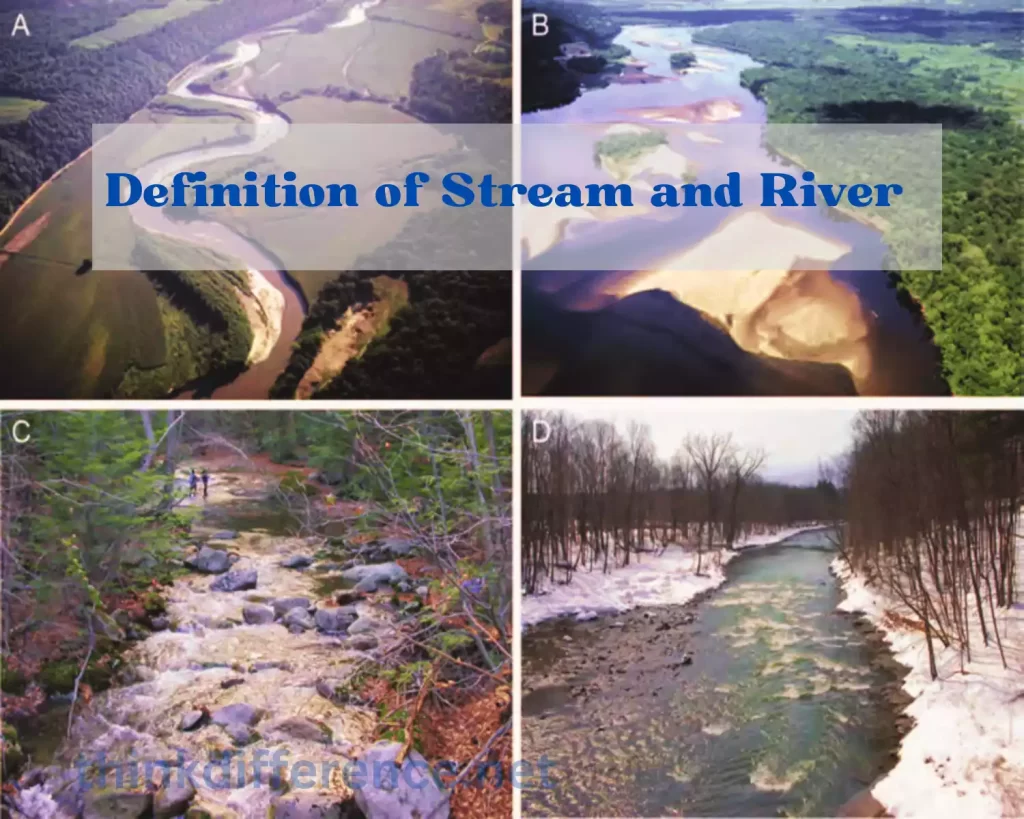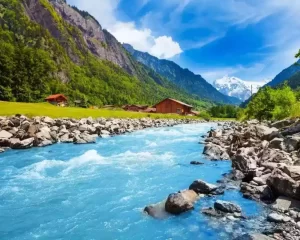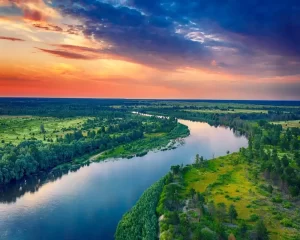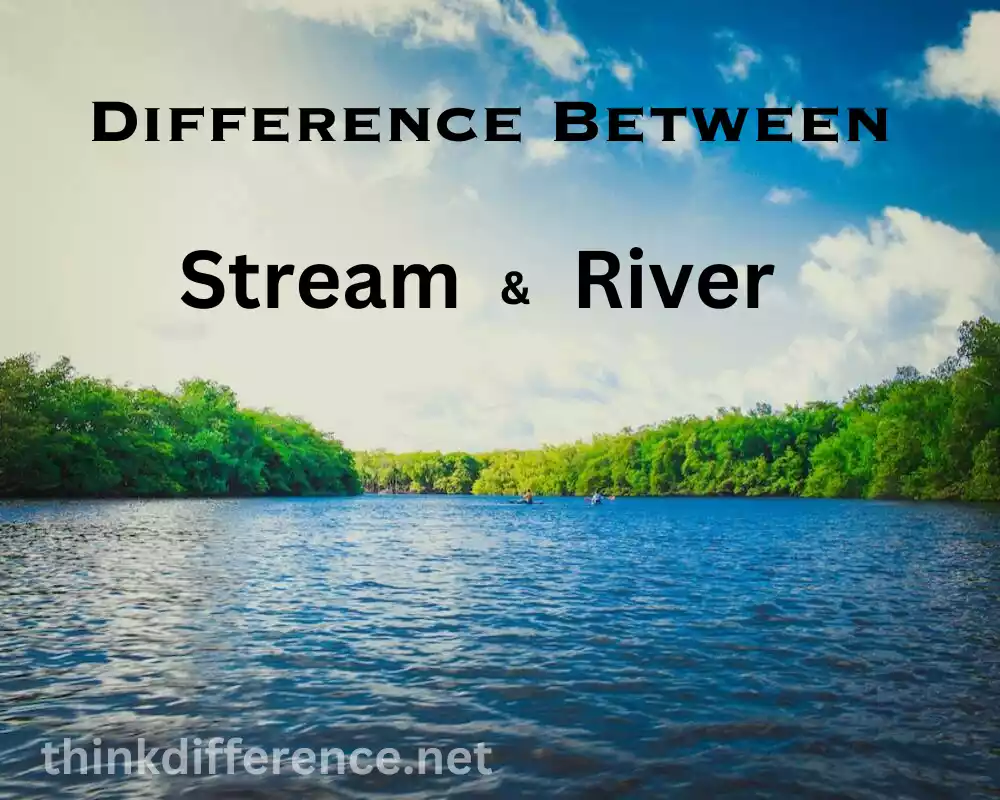Definition of Stream and River
Stream:
A stream is generally defined as an intermittent body of flowing water with narrow channels or beds, typically found flowing throughout a landscape like mountains, forests hills and plains. They are fed by various sources like springs or rainwater but may also come from melting snow or seepage in the soil.
Streams come in all sizes from tiny rivulets to wide rivers flowing for several kilometers on either side. Due to the slope of their land, streams tend to move swiftly with noticeable flow rates depending on season, rainfall and topography – their speed can change even between seasons and locations!
Streams play an essential part in the hydrological cycle by transporting water from higher altitudes down into lower ones, eventually merging with larger bodies such as rivers or lakes. They serve as important habitats for aquatic creatures and plants which enhance biodiversity while contributing to various ecological processes.
Human activities have both positive and negative consequences on streams. Recreational boating, fishing and swimming on streams provide enjoyment. Drinking and irrigation water from them is used for consumption purposes as well. Pollution from industrial runoff, channelization or diversion damage the health of streams as well as organisms who depend on them for survival.

River:
Rivers are expansive natural watercourses which flow at their own leisure over an extensive area, usually wider and deeper than streams. Their flow may originate in springs, melting ice sheets or rainfall, confluences between rivers and streams or confluences with other rivers or streams. Rivers play an essential part in hydrological cycles as part of landscape features as well as essential roles within them themselves.
Rivers come in all sizes from narrow, small channels to huge expanses that span hundreds of miles. Rivers typically follow defined shorelines or banks and flow in channels through defined paths called channels; their flow rates typically surpass that of streams as their topography, climate and the presence of tributaries can all have an influence over them.
Rivers play an invaluable role in shaping landscapes by carrying sediment downstream and eroding land over time, producing valleys, canyons, and deltas as they flow. Rivers support numerous aquatic and terrestrial species as crucial habitats.
History shows us the centrality of rivers to human civilization. From commerce routes and transportation networks, providing access to distant areas, through irrigation and drinking water sources and industrial applications; to reservoirs and dams used as sources for hydropower generation – rivers have always played a central role.
Human activities affecting rivers – like damming and pollution – have an immense effect on their associated ecosystems, necessitating an understanding of both their characteristics and functions for managing and protecting these precious natural resources.
Importance of understanding the difference Stream and River
Understanding the difference between streams and rivers is important for several reasons:
- Ecological Significance: Rivers and streams are distinct aquatic ecosystems with distinctive characteristics and habitats, each one offering something special to us humans. Understanding their differences allows us to appreciate their ecological importance as freshwater environments that support an abundance of species that depend on them for survival, which enables us to craft conservation plans designed to sustain their environments while safeguarding biodiversity.
- Hydrological Understanding: Streams, rivers and lakes all play an essential part of the water cycle, so understanding its distribution within a watershed requires distinguishing among streams, rivers and lakes to understand better the movement of water within each one. Doing this helps assess availability of water for use as well as manage resources more effectively as well as predict possible climate-induced impacts upon streamflow/discharge rates and predict possible climate-induced outcomes such as streamflow reduction/change or discharge increases/decreases.
- Understanding Rivers versus Streams for Land Use Planning: Understanding the difference between rivers and streams is integral for successful planning of land use and development projects. With their smaller size and limited water volume, streams tend to be more vulnerable to disturbance. Acknowledging this distinction will assist with making better decisions regarding land use zones while protecting riparian areas and decreasing human impact on these waterbodies.
- Recreation and tourism: River and stream waters serve multiple uses including drinking water, irrigation, industrial processes and hydropower production. Distinguishing between them in order to accurately gauge availability and flow characteristics for efficient allocation and planning purposes.
- Recreation and Tourism: Rivers and streams offer recreation activities like fishing, boating and swimming that make rivers and streams enjoyable places. Understanding their difference helps identify appropriate locations for various recreational pursuits as well as ensure conservation measures are put in place that preserve natural beauty as well as recreational value of these waterbodies.
- Environmental Impact Assessment: Understanding the distinctions between rivers and streams is vital when conducting environmental impact assessments for projects located near bodies of water, providing more accurate evaluation of any possible water impacts, habitat fragmentation or ecological implications of development projects nearby. Understanding these distinctions also facilitates effective mitigation measures as well as sustainable development practices that ensure their sustainability.
Understanding the distinctions between streams and rivers can shed light on their unique features, ecological functions and human uses. Such knowledge is integral for conservation efforts, sustainable land use planning and water management as well as maintaining healthy freshwater eco-systems.
Characteristics of a Stream
Streams distinguish themselves from other bodies of water in several key ways.

Here are a few distinguishing characteristics:
- Size and Width: Streams tend to be narrower and smaller than rivers; these watercourses range in width from small rivulets up to multiple-meter wide channels and their width usually sits lower on the spectrum than rivers do.
- Flow Rate and Velocity: Streams typically feature a constant waterflow. Its speed can change according to factors like rainfall, season or topography; additionally due to steep gradients, it often flows faster than rivers.
- Source and Drainage Area: Streams can obtain their source water from springs, rainwater or melting snow and are supplied from much smaller draining areas than rivers which receive theirs through an elaborate system of streams and tributaries.
- Water Volume and Discharge: Streams typically possess less water than rivers; their discharge, which measures the volume that passes through an area in an allotted period, tends to be smaller; though its magnitude depends on various factors that impact on its movement such as rainfall.
- Seasonal Variations: Streams can show seasonal differences in their water flow and level. They may increase during heavy rainfall or snowmelt events while during drier months water levels drop and even temporarily dry up smaller streams.
- Physical Features of Streams: Many streams possess distinctive physical features which add depth and variety to their dynamics. Channels and banks that direct water are common features, along with pools and riffles which create areas in which its movement slows or speeds up; meanders characterized by curving channels may also contribute. Those streams with steep elevation changes often include cascades or waterfalls to add an element of surprise!
- Ecosystems and Habitats: Streams provide home to numerous ecosystems, such as aquatic plants, alga, fish and invertebrates. Riparian vegetation plays a pivotal role in maintaining water quality as well as shelter for wildlife.
Understanding the characteristics and functions of streams are integral for assessing ecological health, managing resources and implementing conservation measures. Recognizing their unique role within the water cycle as well as in larger watershed context can provide crucial context.
Characteristics of a River
Rivers stand out among other bodies of water with their distinctive characteristics that set them apart.

Here are a few traits that define a river:
- Size and Width: Rivers tend to be larger and wider than streams; their sizes can range anywhere from tiny streams to vast waterways. Their width also tends to be wider with larger channels and banks than streams do.
- Flow Rate and Velocity: Rivers have an ongoing flow of water which may travel at considerable speed. Due to a gentler gradient, stream waters tend to move quicker. There may also be sections within rivers with fast moving currents known as cascades or rapids that cause variations.
- Source and Drainage Area: Rivers can draw their source water from multiple sources including streams, tributaries and springs. Because rivers have greater drainage areas than streams do they collect water from more contributing watercourses in order to collect sufficient quantities for processing.
- Water Volume and Discharge: Rivers are considerably larger in volume than streams due to their vast drainage areas and high flow rates, carrying massive volumes of water at any one time. A river’s ability to transport so much more volume across a certain section in an instantaneous period than streams makes this even more apparent.
- Seasonal Variations: Rivers exhibit seasonal changes similar to streams. When heavy rainfall or snowmelt hits, rivers may experience higher flow rates followed by lower flow rates during a short timeframe; due to their larger sizes however, rivers usually maintain consistent flows all year-long unlike smaller streams which tend to experience frequent variations in flow rate fluctuations.
- Physical Features of Rivers: Rivers have distinctive physical features shaped by water flow and erosional forces that manifest as channels and banks with wider widths to hold larger volumes of water, deltas (formed by abandoned meander loops), oxbows (formed when river meets large body of water such as lakes or oceans) or rapids, gorges or waterfalls depending on topography in their path.
- Ecosystem and Habitat: Rivers provide vital habitats to many aquatic and terrestrial organisms. From migrating fish species, to invertebrates and plants as well as the abundant floodplain habitats found nearby which increase biodiversity of an ecosystem, rivers play an essential part.
Understanding river characteristics is critical to managing water resources effectively and assessing their ecological health, while also helping implement effective conservation measures. Understanding rivers also aids us in understanding their significance as habitats in hydrologic systems as well as understanding navigation, flooding control, water supply and hydropower activities that use rivers.
Physical Features
Both rivers and streams possess physical features which impact their characteristics and behaviors. Including these features frequently found along rivers or streams:
- Channels and banks: In streams, rivers and lakes there are clearly defined channels which direct waterflow. Their width and depth may be altered depending on flow characteristics as well as size of body of water; banks serve to stabilize channels by surrounding them with rocks, soil or vegetation forming edges along their edge or side walls.
- Riffles and Pools: Streams can often be divided into sections that alternate between riffles and pools, the deeper areas providing habitat for aquatic organisms while shallower, faster-flowing sections, such as those marked by gravel or stones, can serve as riffles.
- Meanders: Meanders occur when there are sinuous bends or twists in a river’s or stream’s flow, due to erosion from flowing water on banks causing lateral migration of sedimentary layers along its course. Meanders can often be found more commonly on large rivers; eventually leading to their creation over time of oxbow-shaped lakes.
- Waterfalls and Cascades: In areas with significant elevation differences, rivers and streams may form waterfalls when their course flows over an abrupt drop or near-vertical fall, creating impressive and picturesque features. Waterfalls may also form due to geological structures or rocks layers which resist erosion that provide support.
- Oxbow Lakes: Crescent-Shaped Water Bodies Made By River Meandering and Cutting Off Loop Oxbow lakes form when rivers meander and cut off loops, leaving behind water-filled depressions which may remain stagnant or isolated over time, even changing in terms of flow rates as they age, supporting ecosystems independent from those on main river channel.
- Deltas and Estuaries: Deltas are landforms found at the mouths of rivers where they empty into larger bodies of water like lakes, seas or oceans, created from sediment carried downstream in rivers that end up creating fertile habitats that often support biodiverse communities. Estuaries form when rivers meet oceans forming transitional zones influenced both by fresh and salt water elements.
- Rapids and Gorges: Rapids and Gorges are river sections characterized by swift waterflow over obstacles or rocks, producing whitewater with turbulent currents. Rapids can often be found where there is an abrupt gradient shift or course change while Gorges are narrow canyons formed over time by river erosion that are found where resistant rock formations exist.
River and stream features add to the visual aesthetic and dynamic energy of rivers and streams, contributing significantly to geomorphology and habitat of their surrounding environments. Understanding such features is integral for land management, recreation, conservation efforts and many other reasons.
Ecosystem and Habitat
Streams, rivers and their environments play an integral role in ecosystems. Their presence provides diverse habitats while increasing biodiversity across landscapes. Here are just a few habitats and ecosystems they support:
- Aquatic Plants and Algae: Rivers and lakes provide ideal environments for aquatic plants and algae to flourish, including submerged (pondweed/waterweed), floating (lily pads/duckweed), emerging (cattails and Reeds) as well as submersed/submerged varieties like duckweed/pondweed etc. Aquatic vegetation plays an essential role in providing oxygen, food shelter and protection to many organisms while simultaneously stabilizing stream banks.
- Invertebrates and Fish: Rivers and streams provide home for an abundance of aquatic organisms such as invertebrates such as crustaceans, mollusks and insects that serve as sustenance to various fish species ranging from minnows up to large predatory ones. Fish species range in size depending on the characteristics of each body of water that hosts it – minnows may range up to large predatory ones depending on size of body of water where living; similar dynamics apply for invertebrate populations serving both species.
- Riparian Vegetation: Riparian zones, which border streams and rivers impacted by water, often boast diverse plant communities such as trees, shrubs and herbaceous species that help stabilize riverbanks and prevent erosion; in addition to providing shade, organic matter for water purification purposes and overall improving their ecological health benefits.
- Floodplain Habitats: Rivers and floodwaters play an instrumental role in shaping floodplain habitats. Floodplains are low lying areas which regularly become submerged by flooding waters; their rich nutrient-rich soils support diverse plant communities while serving as feeding and breeding grounds for numerous birds, mammals, amphibians and other creatures that inhabit them.
- Wetlands and Marshes: When streams join with marshes or wetlands, transitional eco-systems called “riparian wetland” form. These vital habitats support multiple species including waterfowl and wading birds as well as reptiles, amphibians, wetland plants with specific wetland properties as well as filtering out contaminants from water supplies reducing flooding risks while contributing to overall ecosystem health.
Interconnected streams, rivers and habitats form an intricate ecosystem. Freshwater ecologies are sensitive to changes in water quality, habitat degradation and flow patterns; understanding and protecting streams’ diverse habitats, ecological functions and biodiversity is integral for maintaining ecological health in general.
Comparison table of Stream and River
Here is a table that summarizes the key differences between Stream and River:
| Characteristic | Stream | River |
|---|---|---|
| Size | Relatively small | Larger |
| Width | Narrow | Wider |
| Flow Rate | Varies depending on factors like rainfall | Generally more consistent |
| Velocity | Faster | Slower |
| Source | Springs, rainwater, groundwater seepage | Multiple sources, including streams and tributaries |
| Drainage Area | Smaller | Larger |
| Water Volume | Lower | Higher |
| Discharge | Smaller | Larger |
| Seasonal Variations | More pronounced | More consistent |
| Physical Features | Channels, banks, pools, riffles | Channels, banks, meanders, oxbow lakes, deltas |
| Ecosystem | Supports diverse aquatic life and riparian vegetation | Supports diverse aquatic life and riparian vegetation |
| Human Uses | Water supply, recreation, irrigation | Water supply, hydropower, navigation, agriculture |
| Impacts | Pollution, habitat destruction, flow regulation | Pollution, habitat destruction, flow regulation |
Human Uses and Impacts
Water bodies such as rivers and lakes have long played an integral part of human civilizations, providing essential resources and benefits. Human activities may have significant effects on these bodies.
Here are some human uses and impacts associated with streams and rivers:
Human Uses:
- Water Supply: Rivers and streams serve as key sources for drinking, irrigation and industrial uses, providing householders, farmers and industries with drinking, irrigation and industrial water needs. Draining can take place to accommodate this.
- Hydropower Generation: Water flowing down rivers can be harnessed for electricity generation through hydropower plants, where dams across rivers create reservoirs which then are controlled through turbines to release this surplus liquid to generate power.
- Navigation and Transportation: Historically, rivers and streams were used as major travel and trading routes; today cargo ships continue to transport goods along major waterways.
- Recreation and Tourism: Rivers and streams offer recreational activities like kayaking, fishing, boating and swimming to attract tourists while simultaneously stimulating local economies. These water bodies boast natural beauty which attract tourists who contribute significantly to local economies through tourism spending.
- Irrigation in Agriculture: Water from rivers and streams is used for irrigating crops, increasing agricultural productivity by using less land for farming purposes.
Impacts:
- Pollution: Rivers and streams can become polluted due to multiple sources, including industrial discharges, agricultural runoffs, sewage discharges and litter. Such pollution poses risks to human health while diminishing water quality and harming aquatic life.
- Habitat Destruction: Alterations to stream and river channels through activities like dredging or straightening can destroy aquatic habitats by altering natural flow patterns, while land development near bodies of water may destroy riparian vegetation as a result of land development or deforestation nearby.
- Flow Regulation: Construction of dams and reservoirs can alter river flows, altering their natural patterns. This has the potential to disrupt ecosystems by impacting fish migration patterns as well as alter the natural dynamics of floodplains.
- Introduction of Non-native Aquatic Species: Human activities involving the introduction of non-native aquatic species can have negative repercussions for native ecosystems, with invasive species becoming dominant and disrupting food chains; altering river and stream ecology or changing their ecology permanently are also major concerns.
- Climate Changes: Climate changes can profoundly change stream and river ecologies by altering precipitation patterns, altering water availability and creating extreme weather events more frequently. Such shifts could impact temperature control, water flow rate as well as aquatic species habitats.
Understanding human impacts and uses on rivers and streams is vital for conservation and sustainable management. This involves taking measures to decrease pollution levels, protect habitats and ensure sustainable management of water resources.
Conclusion
Streams and Rivers are the life force of our planet, sustaining ecosystems, cultures, and economies. Understanding their formation, significance, and challenges is vital to ensuring their preservation for generations to come. By valuing and protecting these lifelines of nature, we can harmonize our relationship with the natural world and pave the way for a sustainable future.



